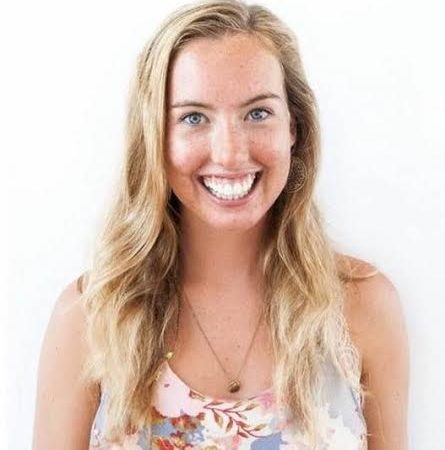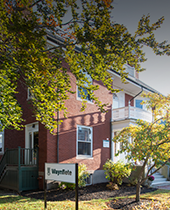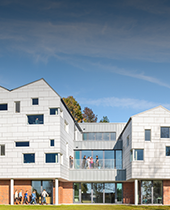Phoebe Colvin-Oehmig ’15 Writes Home Midway Through a Gap Year
I stood in Eden. The warm Bahamian sun browned my shoulders. The turquoise waves lapped at my toes buried in the pink sand. Shorebirds flitted around me. I stepped backwards and within seconds the ocean pooled into my footprints.
Yet, something was terribly wrong with this paradise. As I receded to the high tide line, the turquoise water that gathered in my footprints was made bluer by the fragments of plastic film swirling in the crashing waves. The pink sand that filled my footprints was made redder from fragments of rope, brittle and broken, mixed into the confection of sand. My footprints were filled with infinitudes of tiny pieces of plastic. Bait nets choked the coconuts, lost shoe soles marked their own graves, a rubber toy squid lay lifeless. Instead of Eden, I realized I was standing in a garbage patch.
I first learned about marine litter when I was thirteen. I was given an inscribed copy of the book Tracking Trash: Flotsam, Jetsam and the Science of Ocean Motion by Loree Griffin Burns. Then when I attended Waynflete, my upper school classes in Marine Biology and Environmental Science opened my eyes to the interconnectedness of all fields of study. Through these I developed a passion for environmental stewardship. When I learned about the Cape Eleuthera Island School’s nine-week gap year program, with its mission of sustainability, I knew it was the right start to my gap year.
 At the Island School, electricity came from wind and solar power, the water source was rain, and food was grown through aquaponics or raised locally. Luxuries like long showers and napkins were not allowed. I realized that these comforts come at great cost to our earth and to our future. There, living simply, I picked guavas from trees, and I dove into an underwater world. I watched a schoolmaster snapper dart in out of its reef shelter avoiding barracudas patrolling the water column above. I saw the true workings of a natural ecosystem and I learned this abundance of life is a privilege that needs to be respected and protected. Even in this paradisal landscape, I saw that when the balance of the natural ecosystem is ignored, life fails, as evidenced by the invasive Australian Casuarina trees collapsed on their sides, roots sprawling, near the beach. I saw the impact that living in “comfort” can have on nature and learned the key to longevity of a species is the ability to live indefinitely within the natural limits of an ecosystem.
At the Island School, electricity came from wind and solar power, the water source was rain, and food was grown through aquaponics or raised locally. Luxuries like long showers and napkins were not allowed. I realized that these comforts come at great cost to our earth and to our future. There, living simply, I picked guavas from trees, and I dove into an underwater world. I watched a schoolmaster snapper dart in out of its reef shelter avoiding barracudas patrolling the water column above. I saw the true workings of a natural ecosystem and I learned this abundance of life is a privilege that needs to be respected and protected. Even in this paradisal landscape, I saw that when the balance of the natural ecosystem is ignored, life fails, as evidenced by the invasive Australian Casuarina trees collapsed on their sides, roots sprawling, near the beach. I saw the impact that living in “comfort” can have on nature and learned the key to longevity of a species is the ability to live indefinitely within the natural limits of an ecosystem.
 I spent my days focused on field research, trawling the surface of the Caribbean Sea for plastics. In the lab, I dug my hands into the stomachs of fish, sorting and analyzing the plastics found in them. I discovered there were nearly four million pieces of plastic per square kilometer in the Exuma Sound, and thirty percent of pelagic fish had visible plastics in their stomachs. These plastics harbor toxins that accumulate in their tissues. When humans eat the fish, these toxins can cause cancer, cardiovascular problems and reproductive disorders. They damage our nervous systems, disrupt our immune systems, and trigger allergies and hypersensitivities. In addition, a toxin used in plastic bags interferes with hormone systems. The issue was no longer just about plastics pollution and marine animals; it became an immediate health issue, especially for my Bahamian neighbors who depend on sustenance fishing.
I spent my days focused on field research, trawling the surface of the Caribbean Sea for plastics. In the lab, I dug my hands into the stomachs of fish, sorting and analyzing the plastics found in them. I discovered there were nearly four million pieces of plastic per square kilometer in the Exuma Sound, and thirty percent of pelagic fish had visible plastics in their stomachs. These plastics harbor toxins that accumulate in their tissues. When humans eat the fish, these toxins can cause cancer, cardiovascular problems and reproductive disorders. They damage our nervous systems, disrupt our immune systems, and trigger allergies and hypersensitivities. In addition, a toxin used in plastic bags interferes with hormone systems. The issue was no longer just about plastics pollution and marine animals; it became an immediate health issue, especially for my Bahamian neighbors who depend on sustenance fishing.
I woke to the reality that living healthily and sustainably is not just a matter of effort but involves making decisions with complex social implications. The results of our first-world comforts of disposable plastics are ending up in the Bahamians’ food supply. In addition, the issue of whether their main food source is poisoning them is secondary to the fact that—poisoned or not—the sea is being overfished. Many Eleutherans do not have the means to fish and harvest sustainably, however. If a fisherman can catch a juvenile conch illegally, he has dinner for his family. If he decides not to harvest that conch, there is potential for more in the future, but his family will go hungry that day. It is a fragile and uncomfortable balance between living in the present and planning for the future. When we make policy, we have to find the balance between environmental sustainability and economic sustainability for affected people.
Although I saw an ocean of problems, I know a ripple of good can have a powerful effect. I returned home to Maine with a mission to eliminate Styrofoam and plastic bags in Brunswick. In an effort to raise awareness and to educate the public, I began writing letters to newspaper editors in which I highlighted the equally hazardous environmental effects of both paper and plastic bags, as well as the health risks involved with plastic. I joined “Bring Your Own Bag Midcoast,” a local grassroots environmental advocacy group whose mission is to promote reusable bags and containers. At a recent Brunswick Town Council meeting, our group proposed an ordinance to ban Styrofoam. After I reported the results of the research I did in the Bahamas regarding Styrofoam, the members of the Town Council unanimously voted to begin the process of banning Styrofoam. Of course, with publicity come detractors. I have had to rebut press written in opposition to my efforts. But I was also contacted by the Natural Resources Council of Maine, which offered to fund our mission—further evidence that ripples spread.
I stepped away from comfort this year, from my familiar lifestyle and the expected path from high school into college. I learned to consider outside myself, to live sustainably for the future, to look globally but also to know that action at the local level can bring about real change. You can help by signing a petition for a Styrofoam ban and nickel fee on single use bags in Brunswick and Topsham, Maine by going to bringyourownbag.info.



